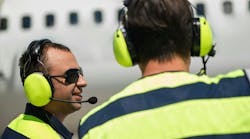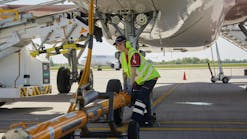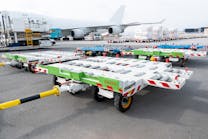How Wet Bulb Globe Temperature Helps Ground Handlers Monitor Working Conditions
It is crucial that time-sensitive ground handling work performed at airports is done efficiently to ensure strong on-time performance. But the safety of the people carrying out that work is even more important.
In order to achieve that balance between safety and efficiency, airports are investing in weather detection equipment, according to Anuj Agrawal, VP of marketing at AEM – which has served the airport market for decades, primarily with lightning detection technology.
“Airports are unique in that operational downtime is very expensive. So, they need real-time, on-the-ground information,” Agrawal says, noting ground service providers can’t make decisions to suspend operations based on generic weather information.
Beyond lightning detection and safety procedures, monitoring for heat stress is vital to personnel safety on the ramp. As a result, commercial organizations are beginning to use wet bulb globe temperature (WBGT) instead of heat index to make informed decisions about working conditions in hot climates.
“Heat index isn’t bad. It’s still good,” Agrawal says. “There’s better ways to do it now with more data.”
What is Wet Bulb Globe Temperature?
Wet bulb globe temperature is an evolution of heat index, explains Agrawal.
“Heat index uses temperature and humidity to form the calculation. It’s certainly adequate, versus nothing. But like anything in the data-driven world we live in now, the more data you have available to you, the more advanced metrics you can create.
“Wet bulb globe temp is basically that. It's still using temperature and humidity, but it's adding in things like wind speed and exposure to sunlight, cloud cover is another component of this,” he continues. “The metric is trying to incorporate those kind of data because those data points are available now.
Why WBGT Matters to Ground Service Providers
The Occupational Safety and Health Administration (OSHA) published a National Emphasis Program (NEP) in April 2022 intended to expand heat-related illness prevention initiatives.
According to Agrawal, the NEP is not quite a regulation, but the focus of these initiatives is trending toward new regulations.
“As OSHA starts thinking about how should this relate to working conditions both outdoors and indoors, they've been in recent years thinking about what kind of standards regulations should we be putting out there to make sure we're protecting workers adequately,” he says, adding the NEP notes OSHA’s preferred guidelines.
“While we don't necessarily have a regulation now, we are going to do more frequent inspections, particularly in industries where we feel like heat stress is more of a risk, and airports and aviation is on that list,” Agrawal says.
Currently, Agrawal explains, guidelines are fairly light in terms. Examples include putting a heat stress plan in place, having a training program that includes heat stress education and identifying heat stress symptoms.
“That's kind of what we're seeing right now. It's mostly guidelines and strong encouragement, if you will, from OSHA. But you know this is going to be a regulation at some point. It’s a long process, but this program is the first step in them indicating that they're taking it seriously,” he adds.
Using WBGT readings can allow ground handlers to be more precise when monitoring for signs of heat stress.
“With wet bulb globe temp, if you have a certain reading – let’s say it's 80 to 85 degrees, sunlight starts to stress the body within 45 minutes with that level. So you should be taking 15 minute breaks every hour to make sure your body can withstand that. When you get to 85 to 88 degrees, the stress starts to happen up to 30 minutes,” he says. “That's why direct and accurate measurements are very important, because a few degrees will matter and have a big impact on what your plan needs to be. When you get to 90 degrees, it's literally 20 minutes. So, you need to be taking very frequent breaks then.”
How to Utilize WBGT
Like any weather data available, if an organization is using publicly available information, it can get a public reading of the wet bulb globe temp is in a specific area, Agrawal notes.
“But we know that that's not accurate. If you're measuring things 20 miles away, that show up on your mobile phone, that's not going to be accurate,” he advises. “It's a guide.”
Placing ground sensors close to working conditions allows for accuracy.
“In an industry like aviation, downtime has real dollars attached to it. And so you could make nominal investments in putting ground sensors at the airport and near the gates that are measuring these parameters like temperature, humidity and solar radiation, so you can get a real-time reading right where the workers are,” he says.
Next, he suggests equipping personnel with basic technology that can take real-time readings from those sensors and quickly calculate the WBGT and send out alerts to mobile phones or operations personnel.
“When it's getting to a certain level, you can get people on alert and just be wary that we may need to shut down operations, so people can be prepared. Then when it hits that threshold … you'll get that reading that you should be stopping operations,” Agrawal says.
“Airports already have this kind of process because of the lightning detection that they’re implementing. Wet bulb globe temp is a natural extension of that whereas instead of lightning detection sensors, you are using these weather sensors and you're inputting into a system that can calculate wet bulb globe temp.
“It’s a very easy system for them to implement,” he adds. “For the costs of downtime it saves, it’s a very nominal investment to do it, and you can get ahead of any potential regulations that are coming.”
WBGT is just one of the environmental risks that ground handlers are facing, Agrawal concludes, noting programs for all types of environmental risk are important for the safety of ground personnel.










